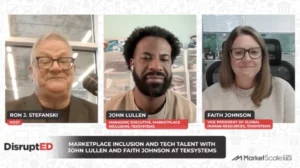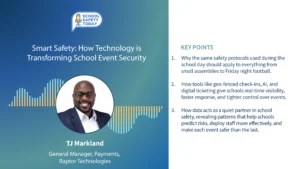How Microsoft Education is Embracing the New Normal
Anthony Salcito doesn’t want things to go back to normal. Rather, he wants things to get better. As VP of Worldwide Education at Microsoft, he has navigated the company’s response to the pandemic across the planet. In this episode of EdTech Today, Anthony examines the new tools and techniques used in this massive beta test of remote learning and suggests how education can build upon the experiences of this crisis.
Microsoft Education posted a list of remote classroom solutions
Bringing the online classroom to life for students
- It’s important for students to see their teacher and classmates at the same time during remote learning. That’s why Teams expanded to a 7×7 Gallery View, allowing up to 49 students to be visible on video at one time.
- Another way to mimic the classroom setting is through Together Mode. An alternative to Gallery View, this feature has brought students out of their individual tiles and transported them into a shared setting—whether that’s a virtual auditorium, conference room, or coffee shop.
- A smaller setting can also help foster student participation. Breakout Rooms have helped students work within smaller groups for a discussion or assignment, just like they would in an in-person classroom.
- The new Spotlight feature has allowed teachers to control the main video feed that students see during class. This can help students focus on the presenter, rather than on the many faces on the screen.
- It has also been critical to provide students with the right devices during remote and hybrid learning. Windows 10 devices have been crucial in giving reliable, secure technology to learn from anywhere.
Staying organized and productive while teaching and learning from home
- Education Insights in Microsoft Teams uses at-a-glance data views to catch teachers up on their students’ activity, from turning in assignments to engaging in class conversations. The Insights dashboard can save teachers time in planning, giving feedback to students, and providing help.
- Microsoft Lists have made it easy for both teachers and students to stay organized, assign responsibilities, manage their schedules, and more. These virtual to-do lists provide a simple and smart way to make sure everyone meets their deadlines.
- Teachers can use the Rubrics tool in Assignments to create customizable, reusable rubrics. These help students understand the criteria they’ll be graded against and enable teachers to better evaluate their students’ work.
- Assignment Notifications have allowed teachers to notify students about upcoming assignments, giving teachers more flexibility in how they choose to communicate with students and assign them projects.
Supporting students and developing their social-emotional learning
- Technology can play a key part in developing social-emotional learning (SEL) from home. SEL-specific Praise Badges and Stickers have helped teachers recognize student social skills, grow emotional vocabulary, and give valuable recognition to the daily wins in their students’ learning.
- It can be difficult to gauge well-being during remote learning, but with tools like Reflect Messaging in Teams, educators can create a quick check-in to get insights on their students and offer support as needed.
- To spread positivity and encouragement, teachers can share Kindness Cards with students. Each virtual card has ideas, reminders, or inspiration that teachers can use to model kind behavior.
- Many milestone moments for students, like graduation ceremonies and sports finals, were cancelled this spring. Graduation Kits gave students a chance to virtually celebrate their accomplishments at the end of the school year, and Orientation Kits helped students with the return to school through online welcome and information sessions.
Preparing students for the future while still having (virtual) fun
- Many summer camps were canceled due to social distancing recommendations, so Microsoft created Passport to Digital Fun, a free virtual summer camp with weeks of interactive workshops. We also created winter camps to keep students engaged and learning during the winter break.
- Students from around the world imagined solutions to some of today’s most pressing issues through a virtual coding competition with Minecraft: Education Edition.
- To keep students engaged during online learning in other ways, we hosted multiple events such as Global Learning Week, Hack the Classroom, Hour of Code, Imagine Cup Junior, and Global Read Aloud, each attended by thousands of students and educators from around the world. Teachers have also been empowered to create their own virtual events through Flipgrid, which offers advanced features such as augmented reality and video blogs.
- We participated in incredible partnerships to help make online learning fun for students. Learn more about our exciting collaborations with NASA, Wonder Woman 1984, the Smithsonian museums, and Space Jam: A New Legacy.
Building community among educators
- We’ve been inspired by educators’ drive to learn and grow amid this year’s challenges, including through Microsoft Innovative Educator (MIE) programs. This community of educators has continued to thrive as teachers shared their experiences and resources.
- Throughout the year, we participated in a variety of in-person and virtual events for teachers, including BETT, EDUCAUSE, Education Transformation Summit, and ISTE20 Live. Each of these events helped educators find community, support, and resources during an unpredictable year.
- Global connections were perhaps more important in this year than any. Microsoft continued to build connections with educator communities, seeking to empower teachers with training resources through the Microsoft Educator Center and events like the Global Training Partners Summit, where Microsoft-trained educators help others around the world meet their unique challenges.
We will carry each of these highlights with us as we look to 2021, and hope you will too. We are optimistic about what the next year will bring for the Microsoft Education community—and know that we will continue to learn and grow together.









